Financial and Economic Literacy for Managers: A Business Report
VerifiedAdded on 2020/10/23
|13
|3355
|390
Report
AI Summary
This report delves into the crucial aspects of financial and economic literacy for business managers, offering a comprehensive overview of topics essential for business growth and expansion. It explores business expansion strategies utilizing globalization and multinational companies, examining their impact and associated risks. The report analyzes macroeconomic policies implemented by the UK government to improve the economy, including monetary, fiscal, and supply-side policies. Furthermore, it covers key business economics concepts such as market structure, demand and supply, and their influence on business operations. The report also examines management accounting cost concepts and budgeting, including amortization schedules, present value calculations, and net present value analysis. This report aims to equip managers with the necessary knowledge and skills to navigate financial and economic challenges, make informed decisions, and drive business success.
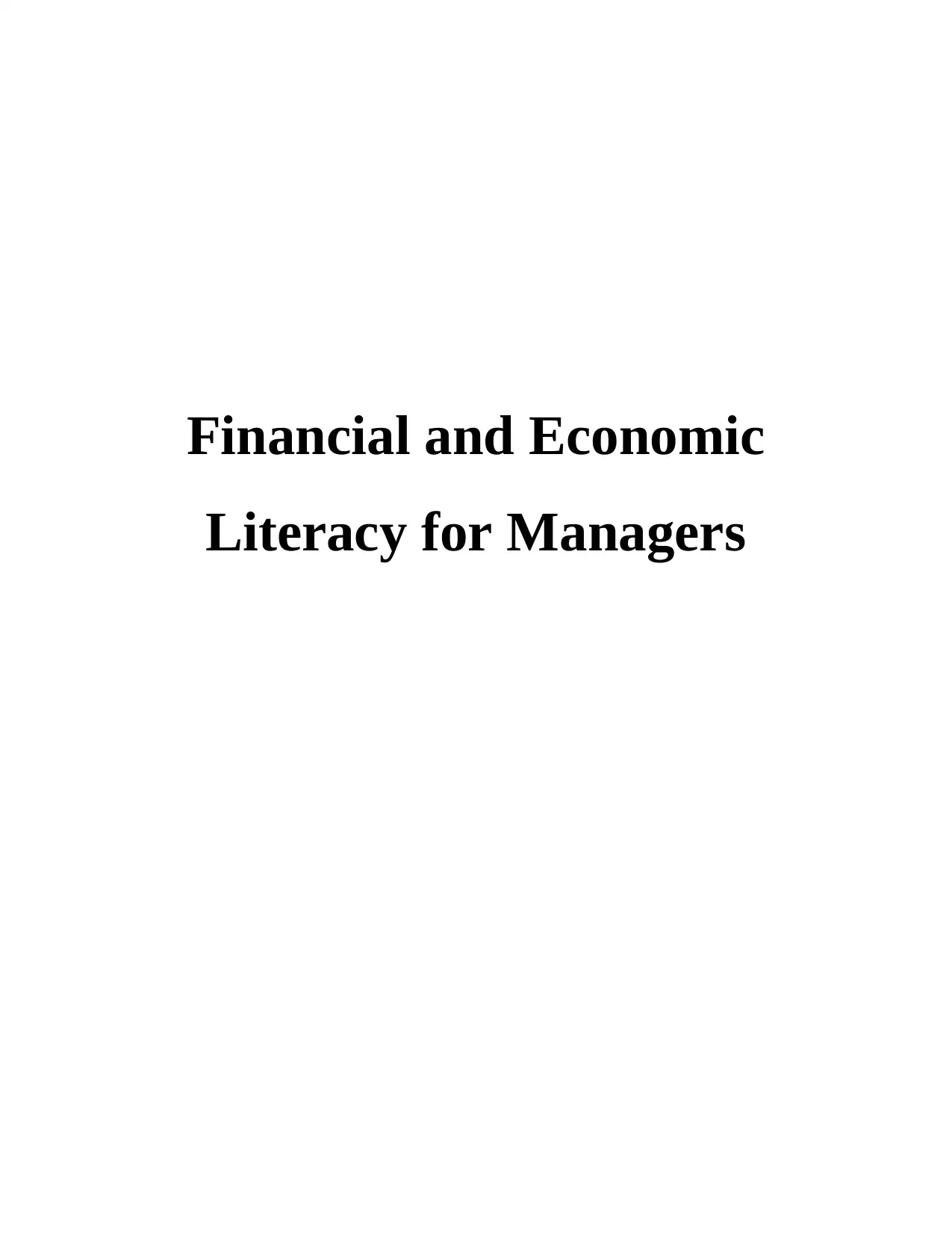
Financial and Economic
Literacy for Managers
Literacy for Managers
Paraphrase This Document
Need a fresh take? Get an instant paraphrase of this document with our AI Paraphraser
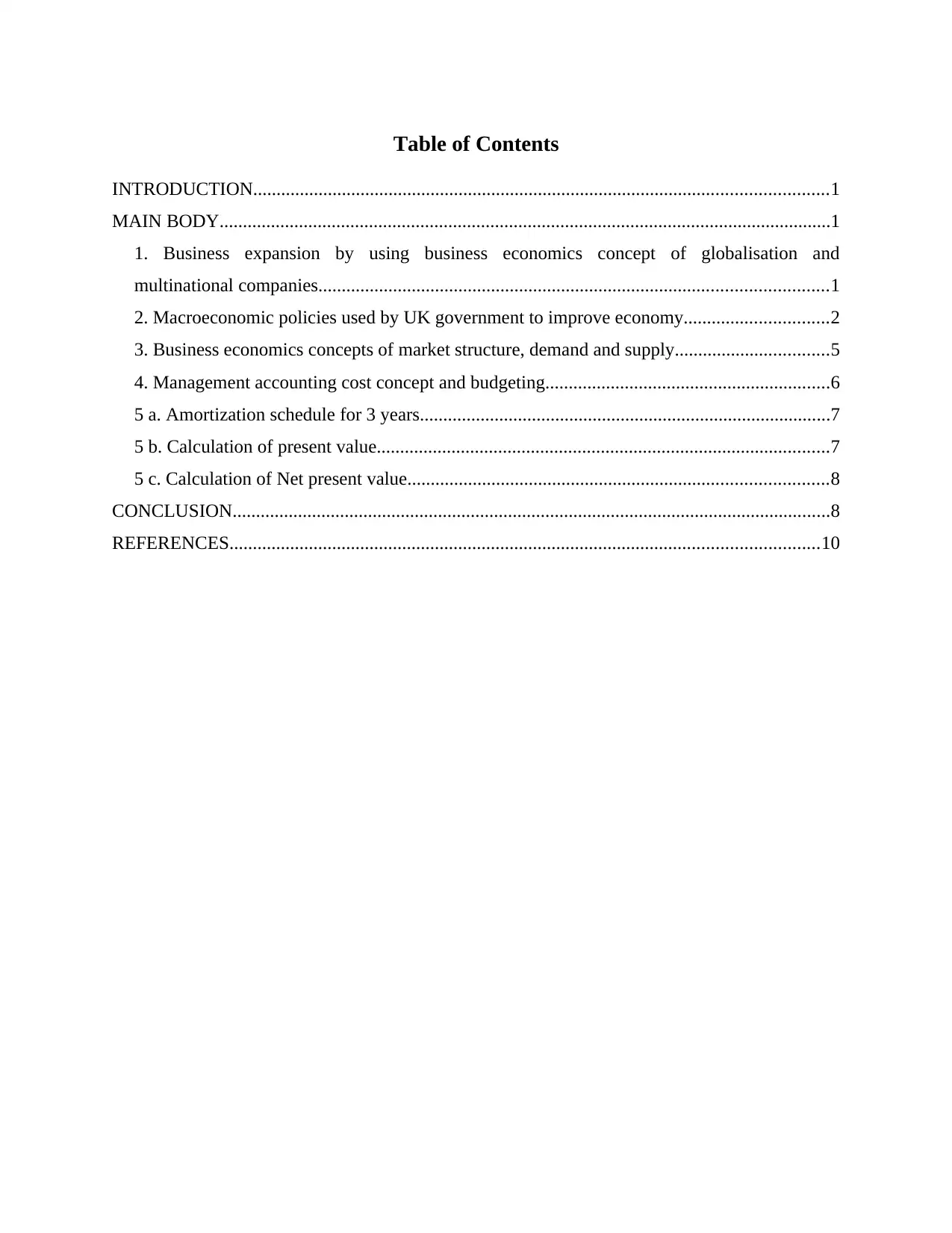
Table of Contents
INTRODUCTION...........................................................................................................................1
MAIN BODY...................................................................................................................................1
1. Business expansion by using business economics concept of globalisation and
multinational companies.............................................................................................................1
2. Macroeconomic policies used by UK government to improve economy...............................2
3. Business economics concepts of market structure, demand and supply.................................5
4. Management accounting cost concept and budgeting.............................................................6
5 a. Amortization schedule for 3 years........................................................................................7
5 b. Calculation of present value.................................................................................................7
5 c. Calculation of Net present value..........................................................................................8
CONCLUSION................................................................................................................................8
REFERENCES..............................................................................................................................10
INTRODUCTION...........................................................................................................................1
MAIN BODY...................................................................................................................................1
1. Business expansion by using business economics concept of globalisation and
multinational companies.............................................................................................................1
2. Macroeconomic policies used by UK government to improve economy...............................2
3. Business economics concepts of market structure, demand and supply.................................5
4. Management accounting cost concept and budgeting.............................................................6
5 a. Amortization schedule for 3 years........................................................................................7
5 b. Calculation of present value.................................................................................................7
5 c. Calculation of Net present value..........................................................................................8
CONCLUSION................................................................................................................................8
REFERENCES..............................................................................................................................10
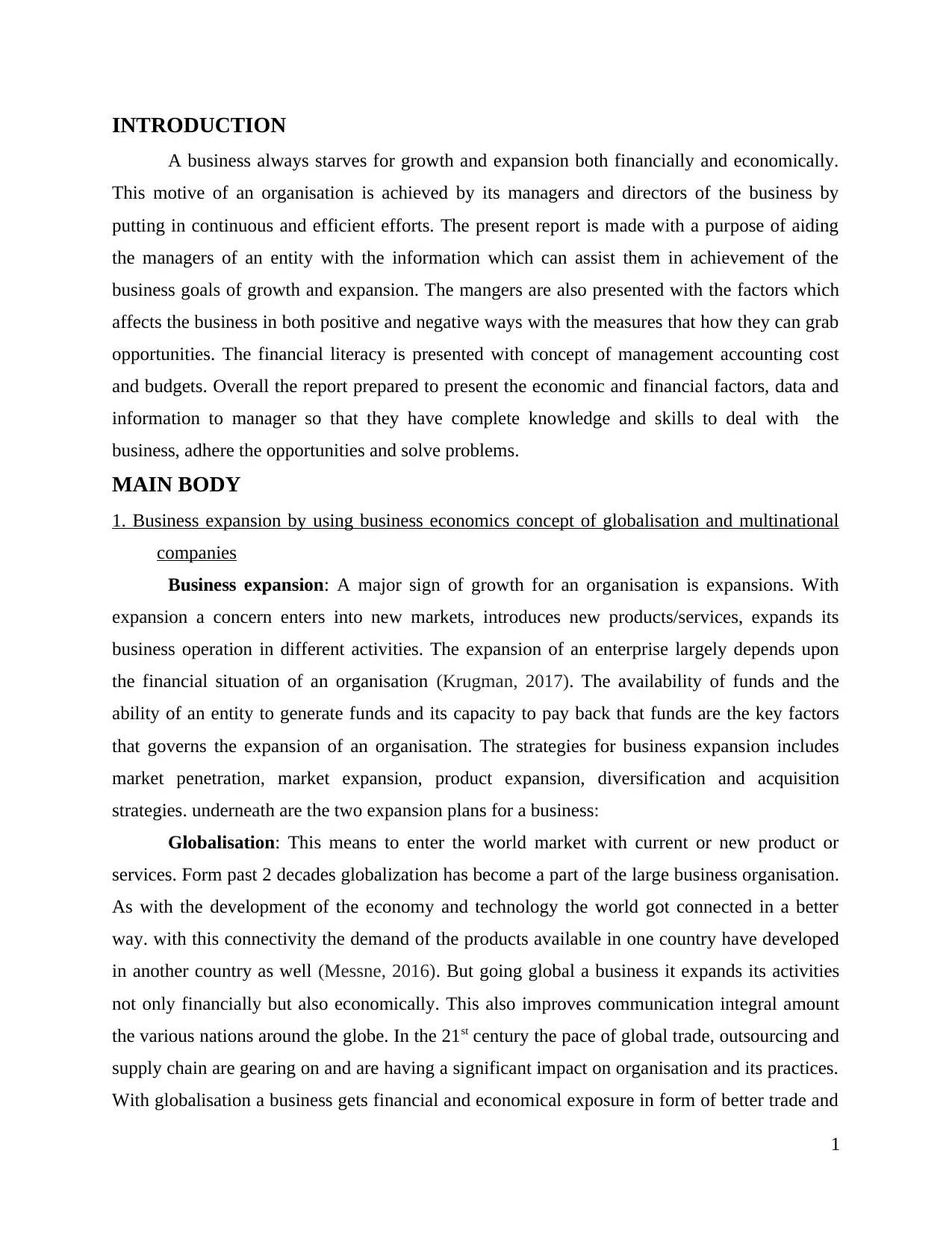
INTRODUCTION
A business always starves for growth and expansion both financially and economically.
This motive of an organisation is achieved by its managers and directors of the business by
putting in continuous and efficient efforts. The present report is made with a purpose of aiding
the managers of an entity with the information which can assist them in achievement of the
business goals of growth and expansion. The mangers are also presented with the factors which
affects the business in both positive and negative ways with the measures that how they can grab
opportunities. The financial literacy is presented with concept of management accounting cost
and budgets. Overall the report prepared to present the economic and financial factors, data and
information to manager so that they have complete knowledge and skills to deal with the
business, adhere the opportunities and solve problems.
MAIN BODY
1. Business expansion by using business economics concept of globalisation and multinational
companies
Business expansion: A major sign of growth for an organisation is expansions. With
expansion a concern enters into new markets, introduces new products/services, expands its
business operation in different activities. The expansion of an enterprise largely depends upon
the financial situation of an organisation (Krugman, 2017). The availability of funds and the
ability of an entity to generate funds and its capacity to pay back that funds are the key factors
that governs the expansion of an organisation. The strategies for business expansion includes
market penetration, market expansion, product expansion, diversification and acquisition
strategies. underneath are the two expansion plans for a business:
Globalisation: This means to enter the world market with current or new product or
services. Form past 2 decades globalization has become a part of the large business organisation.
As with the development of the economy and technology the world got connected in a better
way. with this connectivity the demand of the products available in one country have developed
in another country as well (Messne, 2016). But going global a business it expands its activities
not only financially but also economically. This also improves communication integral amount
the various nations around the globe. In the 21st century the pace of global trade, outsourcing and
supply chain are gearing on and are having a significant impact on organisation and its practices.
With globalisation a business gets financial and economical exposure in form of better trade and
1
A business always starves for growth and expansion both financially and economically.
This motive of an organisation is achieved by its managers and directors of the business by
putting in continuous and efficient efforts. The present report is made with a purpose of aiding
the managers of an entity with the information which can assist them in achievement of the
business goals of growth and expansion. The mangers are also presented with the factors which
affects the business in both positive and negative ways with the measures that how they can grab
opportunities. The financial literacy is presented with concept of management accounting cost
and budgets. Overall the report prepared to present the economic and financial factors, data and
information to manager so that they have complete knowledge and skills to deal with the
business, adhere the opportunities and solve problems.
MAIN BODY
1. Business expansion by using business economics concept of globalisation and multinational
companies
Business expansion: A major sign of growth for an organisation is expansions. With
expansion a concern enters into new markets, introduces new products/services, expands its
business operation in different activities. The expansion of an enterprise largely depends upon
the financial situation of an organisation (Krugman, 2017). The availability of funds and the
ability of an entity to generate funds and its capacity to pay back that funds are the key factors
that governs the expansion of an organisation. The strategies for business expansion includes
market penetration, market expansion, product expansion, diversification and acquisition
strategies. underneath are the two expansion plans for a business:
Globalisation: This means to enter the world market with current or new product or
services. Form past 2 decades globalization has become a part of the large business organisation.
As with the development of the economy and technology the world got connected in a better
way. with this connectivity the demand of the products available in one country have developed
in another country as well (Messne, 2016). But going global a business it expands its activities
not only financially but also economically. This also improves communication integral amount
the various nations around the globe. In the 21st century the pace of global trade, outsourcing and
supply chain are gearing on and are having a significant impact on organisation and its practices.
With globalisation a business gets financial and economical exposure in form of better trade and
1
⊘ This is a preview!⊘
Do you want full access?
Subscribe today to unlock all pages.

Trusted by 1+ million students worldwide
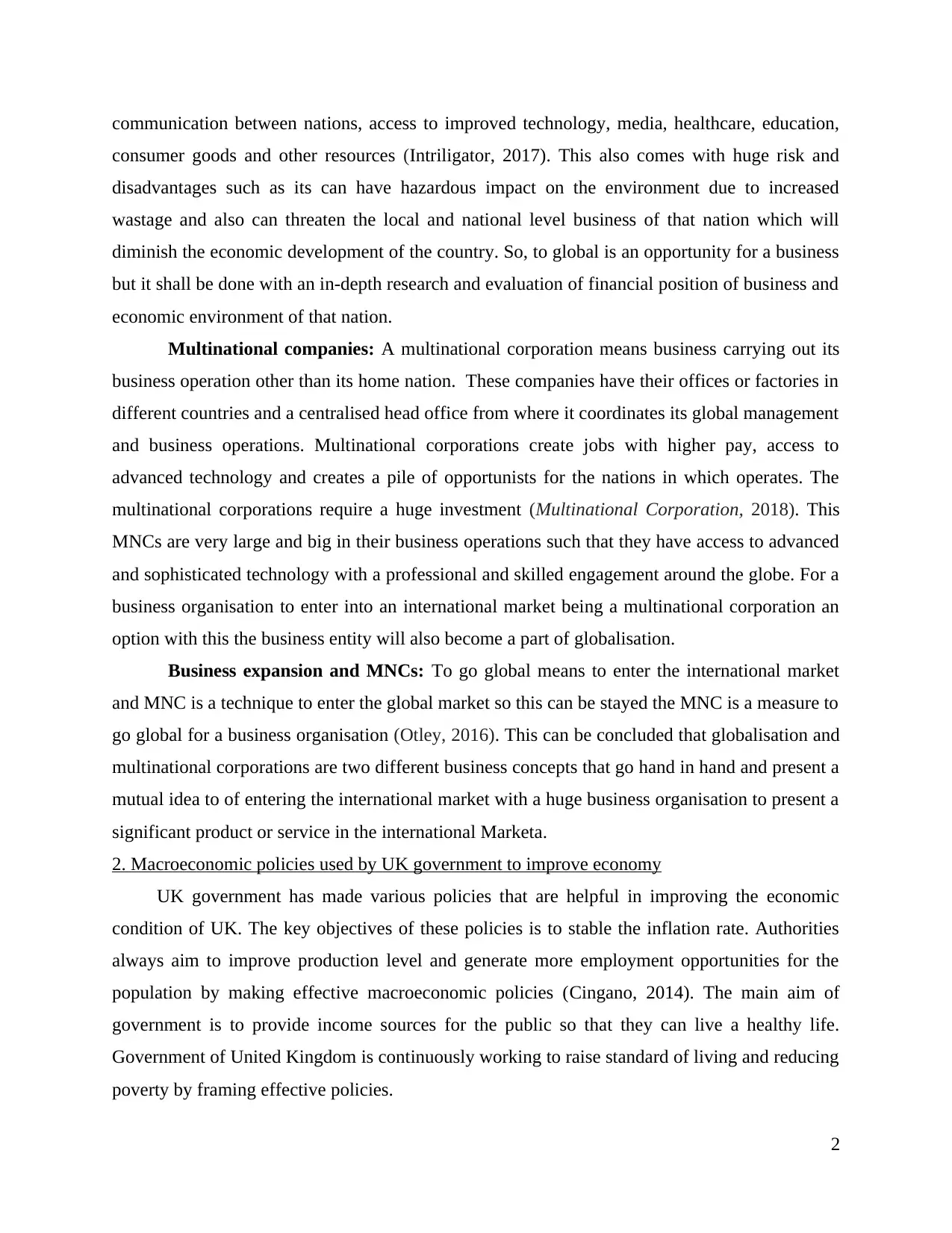
communication between nations, access to improved technology, media, healthcare, education,
consumer goods and other resources (Intriligator, 2017). This also comes with huge risk and
disadvantages such as its can have hazardous impact on the environment due to increased
wastage and also can threaten the local and national level business of that nation which will
diminish the economic development of the country. So, to global is an opportunity for a business
but it shall be done with an in-depth research and evaluation of financial position of business and
economic environment of that nation.
Multinational companies: A multinational corporation means business carrying out its
business operation other than its home nation. These companies have their offices or factories in
different countries and a centralised head office from where it coordinates its global management
and business operations. Multinational corporations create jobs with higher pay, access to
advanced technology and creates a pile of opportunists for the nations in which operates. The
multinational corporations require a huge investment (Multinational Corporation, 2018). This
MNCs are very large and big in their business operations such that they have access to advanced
and sophisticated technology with a professional and skilled engagement around the globe. For a
business organisation to enter into an international market being a multinational corporation an
option with this the business entity will also become a part of globalisation.
Business expansion and MNCs: To go global means to enter the international market
and MNC is a technique to enter the global market so this can be stayed the MNC is a measure to
go global for a business organisation (Otley, 2016). This can be concluded that globalisation and
multinational corporations are two different business concepts that go hand in hand and present a
mutual idea to of entering the international market with a huge business organisation to present a
significant product or service in the international Marketa.
2. Macroeconomic policies used by UK government to improve economy
UK government has made various policies that are helpful in improving the economic
condition of UK. The key objectives of these policies is to stable the inflation rate. Authorities
always aim to improve production level and generate more employment opportunities for the
population by making effective macroeconomic policies (Cingano, 2014). The main aim of
government is to provide income sources for the public so that they can live a healthy life.
Government of United Kingdom is continuously working to raise standard of living and reducing
poverty by framing effective policies.
2
consumer goods and other resources (Intriligator, 2017). This also comes with huge risk and
disadvantages such as its can have hazardous impact on the environment due to increased
wastage and also can threaten the local and national level business of that nation which will
diminish the economic development of the country. So, to global is an opportunity for a business
but it shall be done with an in-depth research and evaluation of financial position of business and
economic environment of that nation.
Multinational companies: A multinational corporation means business carrying out its
business operation other than its home nation. These companies have their offices or factories in
different countries and a centralised head office from where it coordinates its global management
and business operations. Multinational corporations create jobs with higher pay, access to
advanced technology and creates a pile of opportunists for the nations in which operates. The
multinational corporations require a huge investment (Multinational Corporation, 2018). This
MNCs are very large and big in their business operations such that they have access to advanced
and sophisticated technology with a professional and skilled engagement around the globe. For a
business organisation to enter into an international market being a multinational corporation an
option with this the business entity will also become a part of globalisation.
Business expansion and MNCs: To go global means to enter the international market
and MNC is a technique to enter the global market so this can be stayed the MNC is a measure to
go global for a business organisation (Otley, 2016). This can be concluded that globalisation and
multinational corporations are two different business concepts that go hand in hand and present a
mutual idea to of entering the international market with a huge business organisation to present a
significant product or service in the international Marketa.
2. Macroeconomic policies used by UK government to improve economy
UK government has made various policies that are helpful in improving the economic
condition of UK. The key objectives of these policies is to stable the inflation rate. Authorities
always aim to improve production level and generate more employment opportunities for the
population by making effective macroeconomic policies (Cingano, 2014). The main aim of
government is to provide income sources for the public so that they can live a healthy life.
Government of United Kingdom is continuously working to raise standard of living and reducing
poverty by framing effective policies.
2
Paraphrase This Document
Need a fresh take? Get an instant paraphrase of this document with our AI Paraphraser
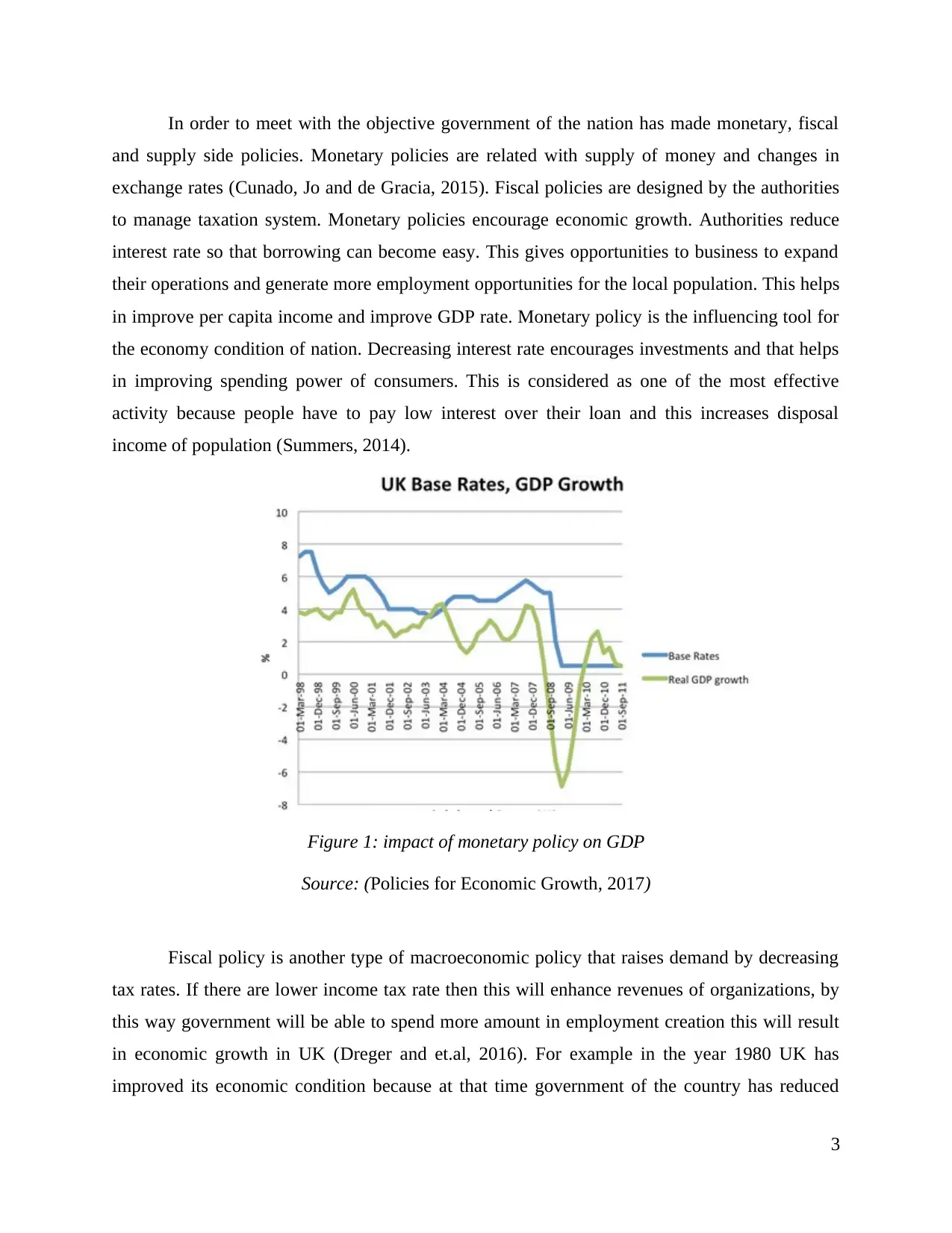
In order to meet with the objective government of the nation has made monetary, fiscal
and supply side policies. Monetary policies are related with supply of money and changes in
exchange rates (Cunado, Jo and de Gracia, 2015). Fiscal policies are designed by the authorities
to manage taxation system. Monetary policies encourage economic growth. Authorities reduce
interest rate so that borrowing can become easy. This gives opportunities to business to expand
their operations and generate more employment opportunities for the local population. This helps
in improve per capita income and improve GDP rate. Monetary policy is the influencing tool for
the economy condition of nation. Decreasing interest rate encourages investments and that helps
in improving spending power of consumers. This is considered as one of the most effective
activity because people have to pay low interest over their loan and this increases disposal
income of population (Summers, 2014).
Figure 1: impact of monetary policy on GDP
Source: (Policies for Economic Growth, 2017)
Fiscal policy is another type of macroeconomic policy that raises demand by decreasing
tax rates. If there are lower income tax rate then this will enhance revenues of organizations, by
this way government will be able to spend more amount in employment creation this will result
in economic growth in UK (Dreger and et.al, 2016). For example in the year 1980 UK has
improved its economic condition because at that time government of the country has reduced
3
and supply side policies. Monetary policies are related with supply of money and changes in
exchange rates (Cunado, Jo and de Gracia, 2015). Fiscal policies are designed by the authorities
to manage taxation system. Monetary policies encourage economic growth. Authorities reduce
interest rate so that borrowing can become easy. This gives opportunities to business to expand
their operations and generate more employment opportunities for the local population. This helps
in improve per capita income and improve GDP rate. Monetary policy is the influencing tool for
the economy condition of nation. Decreasing interest rate encourages investments and that helps
in improving spending power of consumers. This is considered as one of the most effective
activity because people have to pay low interest over their loan and this increases disposal
income of population (Summers, 2014).
Figure 1: impact of monetary policy on GDP
Source: (Policies for Economic Growth, 2017)
Fiscal policy is another type of macroeconomic policy that raises demand by decreasing
tax rates. If there are lower income tax rate then this will enhance revenues of organizations, by
this way government will be able to spend more amount in employment creation this will result
in economic growth in UK (Dreger and et.al, 2016). For example in the year 1980 UK has
improved its economic condition because at that time government of the country has reduced
3
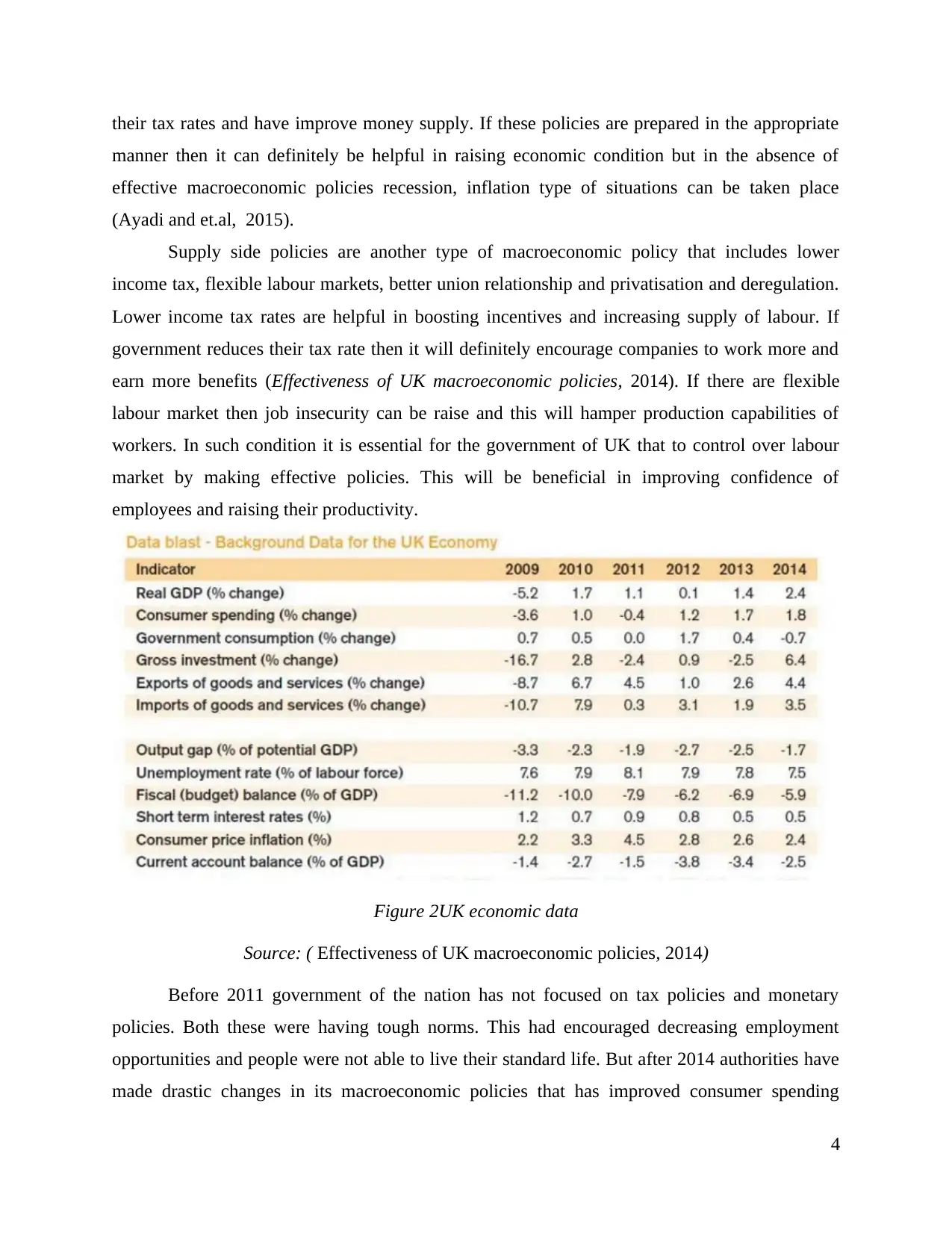
their tax rates and have improve money supply. If these policies are prepared in the appropriate
manner then it can definitely be helpful in raising economic condition but in the absence of
effective macroeconomic policies recession, inflation type of situations can be taken place
(Ayadi and et.al, 2015).
Supply side policies are another type of macroeconomic policy that includes lower
income tax, flexible labour markets, better union relationship and privatisation and deregulation.
Lower income tax rates are helpful in boosting incentives and increasing supply of labour. If
government reduces their tax rate then it will definitely encourage companies to work more and
earn more benefits (Effectiveness of UK macroeconomic policies, 2014). If there are flexible
labour market then job insecurity can be raise and this will hamper production capabilities of
workers. In such condition it is essential for the government of UK that to control over labour
market by making effective policies. This will be beneficial in improving confidence of
employees and raising their productivity.
Figure 2UK economic data
Source: ( Effectiveness of UK macroeconomic policies, 2014)
Before 2011 government of the nation has not focused on tax policies and monetary
policies. Both these were having tough norms. This had encouraged decreasing employment
opportunities and people were not able to live their standard life. But after 2014 authorities have
made drastic changes in its macroeconomic policies that has improved consumer spending
4
manner then it can definitely be helpful in raising economic condition but in the absence of
effective macroeconomic policies recession, inflation type of situations can be taken place
(Ayadi and et.al, 2015).
Supply side policies are another type of macroeconomic policy that includes lower
income tax, flexible labour markets, better union relationship and privatisation and deregulation.
Lower income tax rates are helpful in boosting incentives and increasing supply of labour. If
government reduces their tax rate then it will definitely encourage companies to work more and
earn more benefits (Effectiveness of UK macroeconomic policies, 2014). If there are flexible
labour market then job insecurity can be raise and this will hamper production capabilities of
workers. In such condition it is essential for the government of UK that to control over labour
market by making effective policies. This will be beneficial in improving confidence of
employees and raising their productivity.
Figure 2UK economic data
Source: ( Effectiveness of UK macroeconomic policies, 2014)
Before 2011 government of the nation has not focused on tax policies and monetary
policies. Both these were having tough norms. This had encouraged decreasing employment
opportunities and people were not able to live their standard life. But after 2014 authorities have
made drastic changes in its macroeconomic policies that has improved consumer spending
4
⊘ This is a preview!⊘
Do you want full access?
Subscribe today to unlock all pages.

Trusted by 1+ million students worldwide
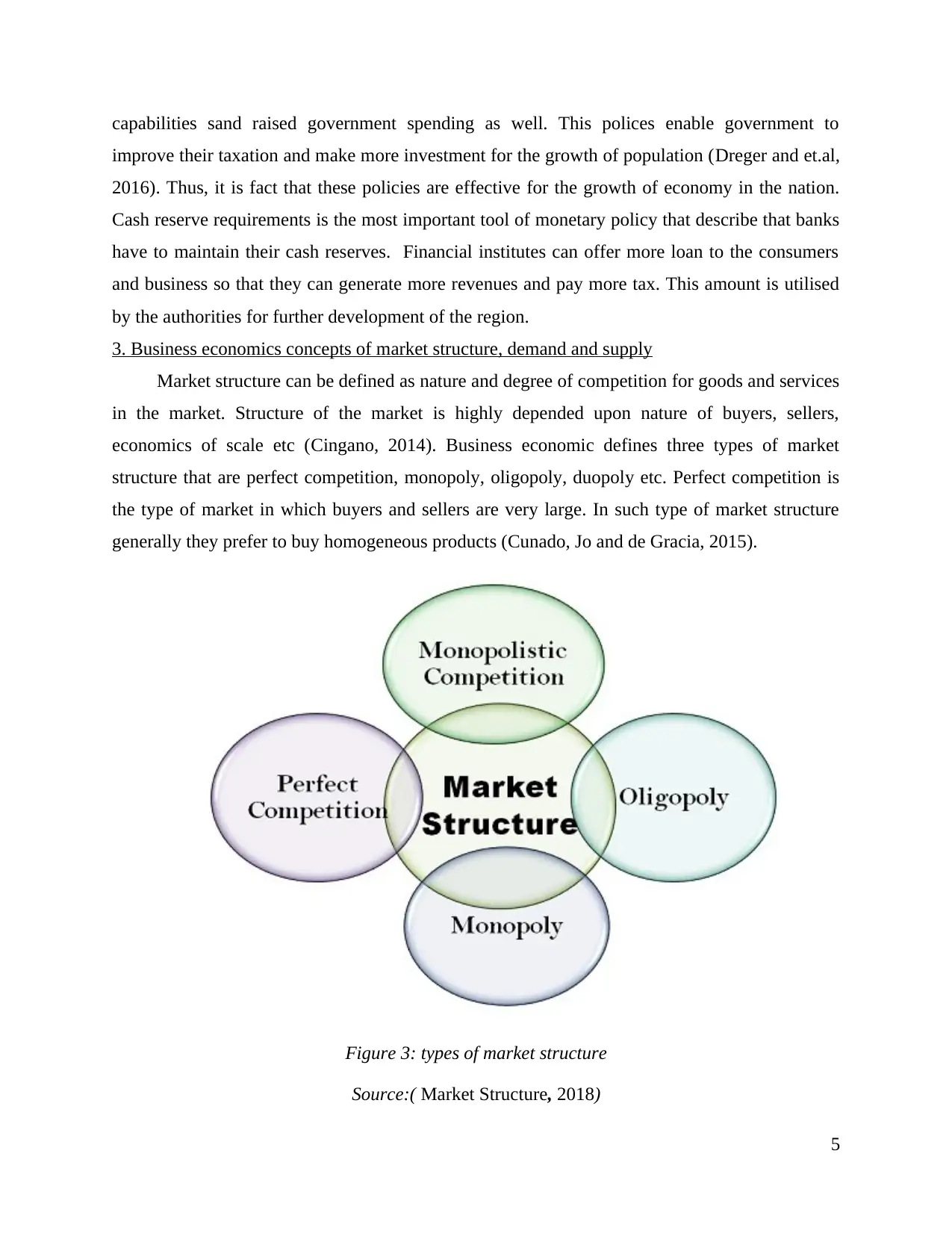
capabilities sand raised government spending as well. This polices enable government to
improve their taxation and make more investment for the growth of population (Dreger and et.al,
2016). Thus, it is fact that these policies are effective for the growth of economy in the nation.
Cash reserve requirements is the most important tool of monetary policy that describe that banks
have to maintain their cash reserves. Financial institutes can offer more loan to the consumers
and business so that they can generate more revenues and pay more tax. This amount is utilised
by the authorities for further development of the region.
3. Business economics concepts of market structure, demand and supply
Market structure can be defined as nature and degree of competition for goods and services
in the market. Structure of the market is highly depended upon nature of buyers, sellers,
economics of scale etc (Cingano, 2014). Business economic defines three types of market
structure that are perfect competition, monopoly, oligopoly, duopoly etc. Perfect competition is
the type of market in which buyers and sellers are very large. In such type of market structure
generally they prefer to buy homogeneous products (Cunado, Jo and de Gracia, 2015).
Figure 3: types of market structure
Source:( Market Structure, 2018)
5
improve their taxation and make more investment for the growth of population (Dreger and et.al,
2016). Thus, it is fact that these policies are effective for the growth of economy in the nation.
Cash reserve requirements is the most important tool of monetary policy that describe that banks
have to maintain their cash reserves. Financial institutes can offer more loan to the consumers
and business so that they can generate more revenues and pay more tax. This amount is utilised
by the authorities for further development of the region.
3. Business economics concepts of market structure, demand and supply
Market structure can be defined as nature and degree of competition for goods and services
in the market. Structure of the market is highly depended upon nature of buyers, sellers,
economics of scale etc (Cingano, 2014). Business economic defines three types of market
structure that are perfect competition, monopoly, oligopoly, duopoly etc. Perfect competition is
the type of market in which buyers and sellers are very large. In such type of market structure
generally they prefer to buy homogeneous products (Cunado, Jo and de Gracia, 2015).
Figure 3: types of market structure
Source:( Market Structure, 2018)
5
Paraphrase This Document
Need a fresh take? Get an instant paraphrase of this document with our AI Paraphraser
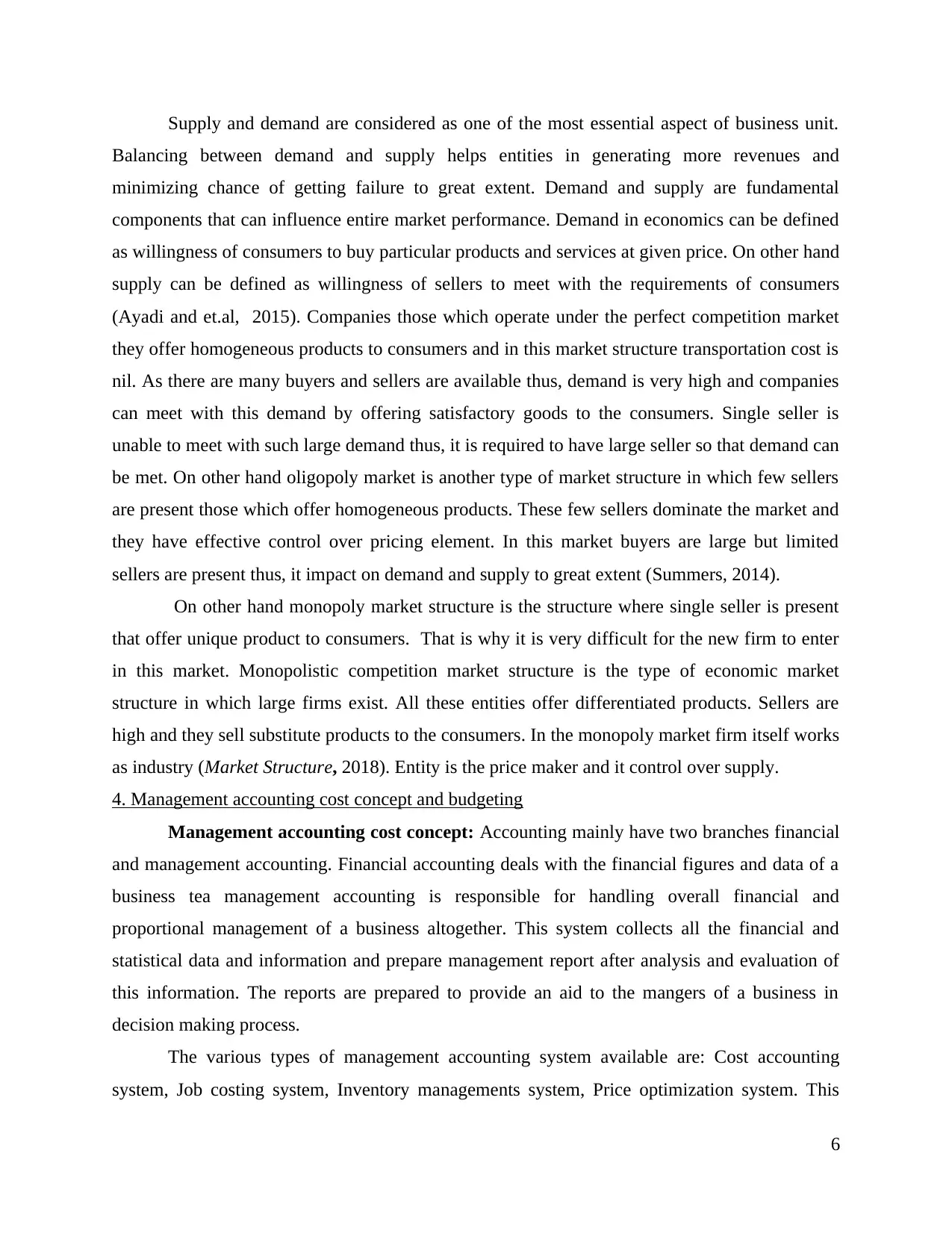
Supply and demand are considered as one of the most essential aspect of business unit.
Balancing between demand and supply helps entities in generating more revenues and
minimizing chance of getting failure to great extent. Demand and supply are fundamental
components that can influence entire market performance. Demand in economics can be defined
as willingness of consumers to buy particular products and services at given price. On other hand
supply can be defined as willingness of sellers to meet with the requirements of consumers
(Ayadi and et.al, 2015). Companies those which operate under the perfect competition market
they offer homogeneous products to consumers and in this market structure transportation cost is
nil. As there are many buyers and sellers are available thus, demand is very high and companies
can meet with this demand by offering satisfactory goods to the consumers. Single seller is
unable to meet with such large demand thus, it is required to have large seller so that demand can
be met. On other hand oligopoly market is another type of market structure in which few sellers
are present those which offer homogeneous products. These few sellers dominate the market and
they have effective control over pricing element. In this market buyers are large but limited
sellers are present thus, it impact on demand and supply to great extent (Summers, 2014).
On other hand monopoly market structure is the structure where single seller is present
that offer unique product to consumers. That is why it is very difficult for the new firm to enter
in this market. Monopolistic competition market structure is the type of economic market
structure in which large firms exist. All these entities offer differentiated products. Sellers are
high and they sell substitute products to the consumers. In the monopoly market firm itself works
as industry (Market Structure, 2018). Entity is the price maker and it control over supply.
4. Management accounting cost concept and budgeting
Management accounting cost concept: Accounting mainly have two branches financial
and management accounting. Financial accounting deals with the financial figures and data of a
business tea management accounting is responsible for handling overall financial and
proportional management of a business altogether. This system collects all the financial and
statistical data and information and prepare management report after analysis and evaluation of
this information. The reports are prepared to provide an aid to the mangers of a business in
decision making process.
The various types of management accounting system available are: Cost accounting
system, Job costing system, Inventory managements system, Price optimization system. This
6
Balancing between demand and supply helps entities in generating more revenues and
minimizing chance of getting failure to great extent. Demand and supply are fundamental
components that can influence entire market performance. Demand in economics can be defined
as willingness of consumers to buy particular products and services at given price. On other hand
supply can be defined as willingness of sellers to meet with the requirements of consumers
(Ayadi and et.al, 2015). Companies those which operate under the perfect competition market
they offer homogeneous products to consumers and in this market structure transportation cost is
nil. As there are many buyers and sellers are available thus, demand is very high and companies
can meet with this demand by offering satisfactory goods to the consumers. Single seller is
unable to meet with such large demand thus, it is required to have large seller so that demand can
be met. On other hand oligopoly market is another type of market structure in which few sellers
are present those which offer homogeneous products. These few sellers dominate the market and
they have effective control over pricing element. In this market buyers are large but limited
sellers are present thus, it impact on demand and supply to great extent (Summers, 2014).
On other hand monopoly market structure is the structure where single seller is present
that offer unique product to consumers. That is why it is very difficult for the new firm to enter
in this market. Monopolistic competition market structure is the type of economic market
structure in which large firms exist. All these entities offer differentiated products. Sellers are
high and they sell substitute products to the consumers. In the monopoly market firm itself works
as industry (Market Structure, 2018). Entity is the price maker and it control over supply.
4. Management accounting cost concept and budgeting
Management accounting cost concept: Accounting mainly have two branches financial
and management accounting. Financial accounting deals with the financial figures and data of a
business tea management accounting is responsible for handling overall financial and
proportional management of a business altogether. This system collects all the financial and
statistical data and information and prepare management report after analysis and evaluation of
this information. The reports are prepared to provide an aid to the mangers of a business in
decision making process.
The various types of management accounting system available are: Cost accounting
system, Job costing system, Inventory managements system, Price optimization system. This
6
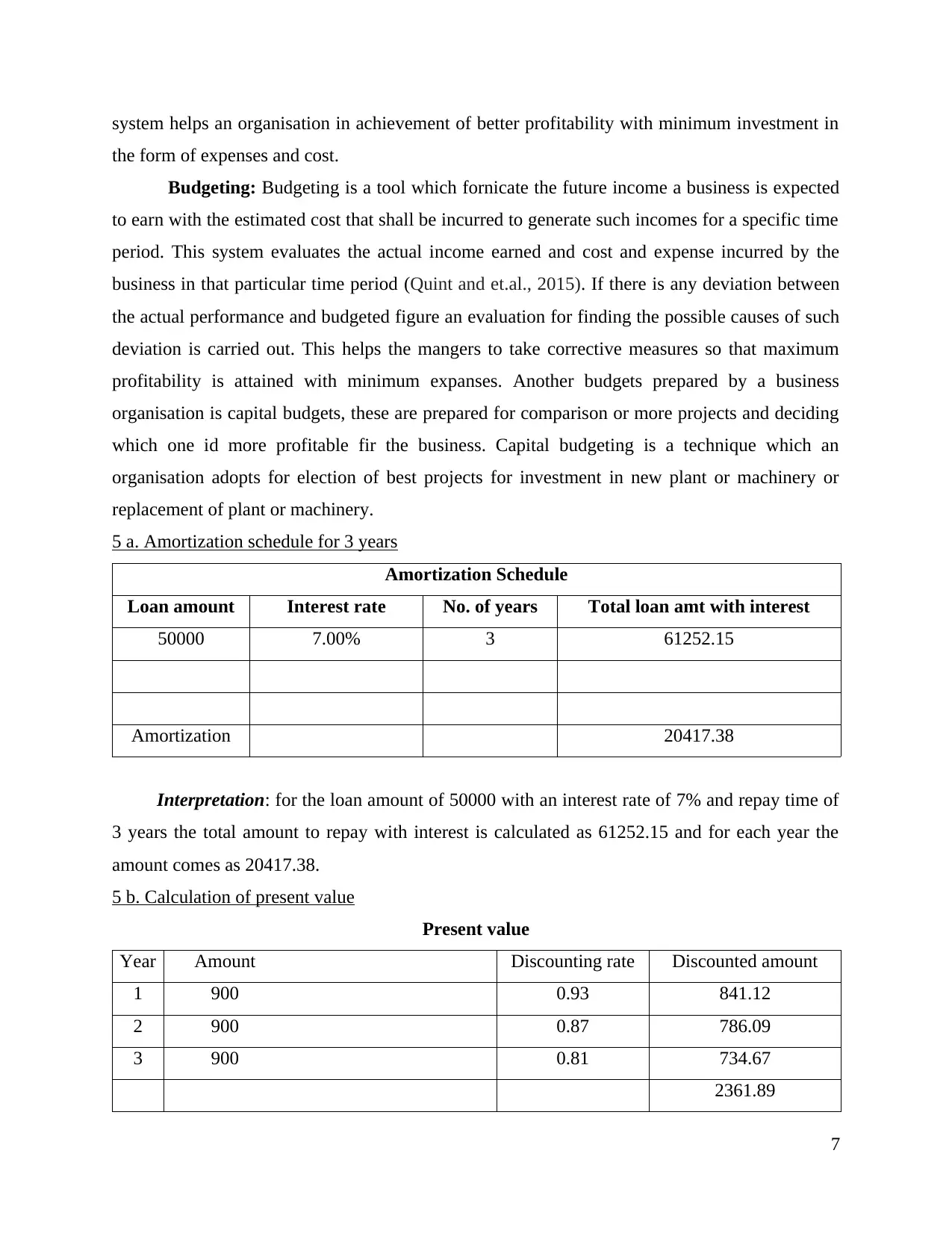
system helps an organisation in achievement of better profitability with minimum investment in
the form of expenses and cost.
Budgeting: Budgeting is a tool which fornicate the future income a business is expected
to earn with the estimated cost that shall be incurred to generate such incomes for a specific time
period. This system evaluates the actual income earned and cost and expense incurred by the
business in that particular time period (Quint and et.al., 2015). If there is any deviation between
the actual performance and budgeted figure an evaluation for finding the possible causes of such
deviation is carried out. This helps the mangers to take corrective measures so that maximum
profitability is attained with minimum expanses. Another budgets prepared by a business
organisation is capital budgets, these are prepared for comparison or more projects and deciding
which one id more profitable fir the business. Capital budgeting is a technique which an
organisation adopts for election of best projects for investment in new plant or machinery or
replacement of plant or machinery.
5 a. Amortization schedule for 3 years
Amortization Schedule
Loan amount Interest rate No. of years Total loan amt with interest
50000 7.00% 3 61252.15
Amortization 20417.38
Interpretation: for the loan amount of 50000 with an interest rate of 7% and repay time of
3 years the total amount to repay with interest is calculated as 61252.15 and for each year the
amount comes as 20417.38.
5 b. Calculation of present value
Present value
Year Amount Discounting rate Discounted amount
1 900 0.93 841.12
2 900 0.87 786.09
3 900 0.81 734.67
2361.89
7
the form of expenses and cost.
Budgeting: Budgeting is a tool which fornicate the future income a business is expected
to earn with the estimated cost that shall be incurred to generate such incomes for a specific time
period. This system evaluates the actual income earned and cost and expense incurred by the
business in that particular time period (Quint and et.al., 2015). If there is any deviation between
the actual performance and budgeted figure an evaluation for finding the possible causes of such
deviation is carried out. This helps the mangers to take corrective measures so that maximum
profitability is attained with minimum expanses. Another budgets prepared by a business
organisation is capital budgets, these are prepared for comparison or more projects and deciding
which one id more profitable fir the business. Capital budgeting is a technique which an
organisation adopts for election of best projects for investment in new plant or machinery or
replacement of plant or machinery.
5 a. Amortization schedule for 3 years
Amortization Schedule
Loan amount Interest rate No. of years Total loan amt with interest
50000 7.00% 3 61252.15
Amortization 20417.38
Interpretation: for the loan amount of 50000 with an interest rate of 7% and repay time of
3 years the total amount to repay with interest is calculated as 61252.15 and for each year the
amount comes as 20417.38.
5 b. Calculation of present value
Present value
Year Amount Discounting rate Discounted amount
1 900 0.93 841.12
2 900 0.87 786.09
3 900 0.81 734.67
2361.89
7
⊘ This is a preview!⊘
Do you want full access?
Subscribe today to unlock all pages.

Trusted by 1+ million students worldwide
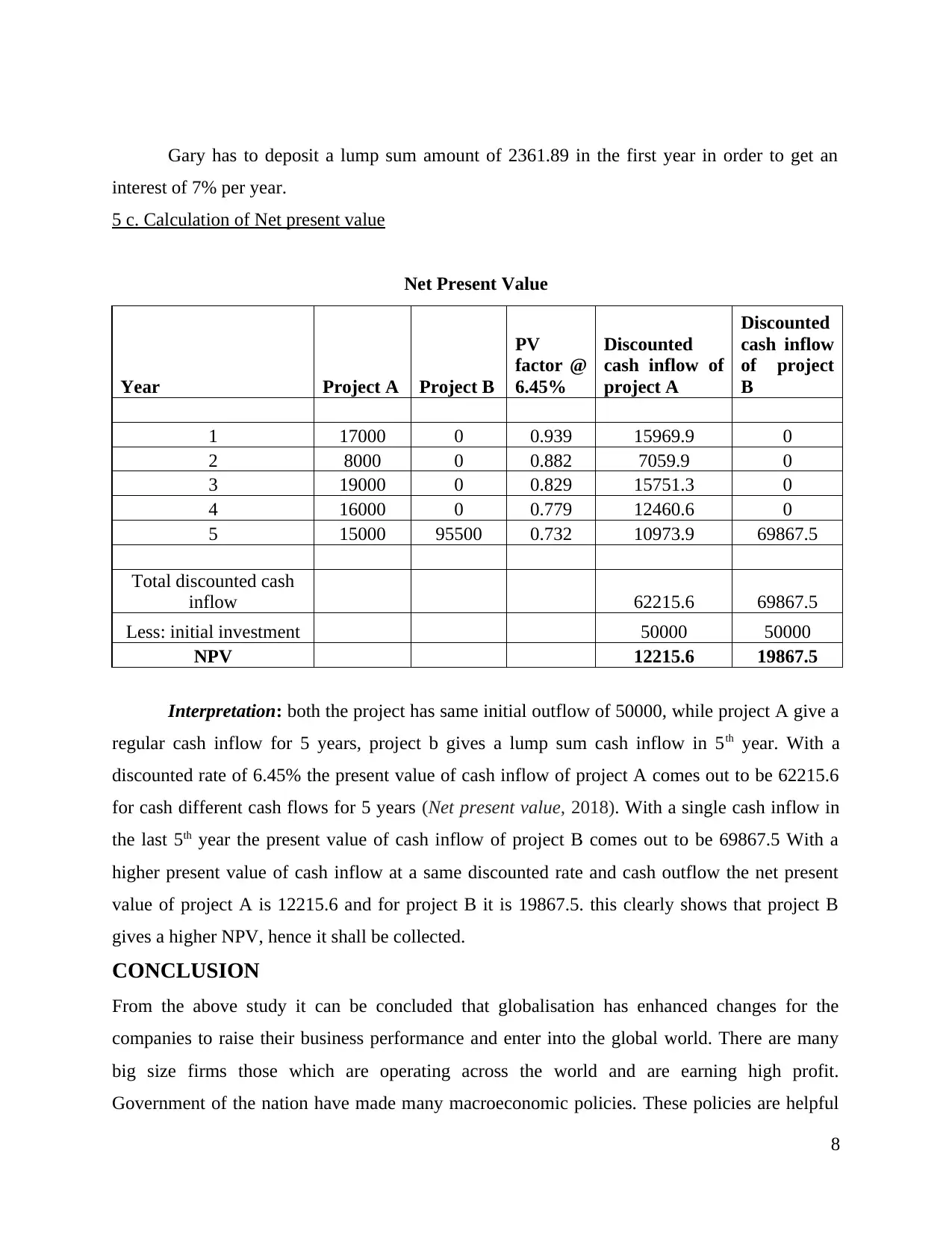
Gary has to deposit a lump sum amount of 2361.89 in the first year in order to get an
interest of 7% per year.
5 c. Calculation of Net present value
Net Present Value
Year Project A Project B
PV
factor @
6.45%
Discounted
cash inflow of
project A
Discounted
cash inflow
of project
B
1 17000 0 0.939 15969.9 0
2 8000 0 0.882 7059.9 0
3 19000 0 0.829 15751.3 0
4 16000 0 0.779 12460.6 0
5 15000 95500 0.732 10973.9 69867.5
Total discounted cash
inflow 62215.6 69867.5
Less: initial investment 50000 50000
NPV 12215.6 19867.5
Interpretation: both the project has same initial outflow of 50000, while project A give a
regular cash inflow for 5 years, project b gives a lump sum cash inflow in 5th year. With a
discounted rate of 6.45% the present value of cash inflow of project A comes out to be 62215.6
for cash different cash flows for 5 years (Net present value, 2018). With a single cash inflow in
the last 5th year the present value of cash inflow of project B comes out to be 69867.5 With a
higher present value of cash inflow at a same discounted rate and cash outflow the net present
value of project A is 12215.6 and for project B it is 19867.5. this clearly shows that project B
gives a higher NPV, hence it shall be collected.
CONCLUSION
From the above study it can be concluded that globalisation has enhanced changes for the
companies to raise their business performance and enter into the global world. There are many
big size firms those which are operating across the world and are earning high profit.
Government of the nation have made many macroeconomic policies. These policies are helpful
8
interest of 7% per year.
5 c. Calculation of Net present value
Net Present Value
Year Project A Project B
PV
factor @
6.45%
Discounted
cash inflow of
project A
Discounted
cash inflow
of project
B
1 17000 0 0.939 15969.9 0
2 8000 0 0.882 7059.9 0
3 19000 0 0.829 15751.3 0
4 16000 0 0.779 12460.6 0
5 15000 95500 0.732 10973.9 69867.5
Total discounted cash
inflow 62215.6 69867.5
Less: initial investment 50000 50000
NPV 12215.6 19867.5
Interpretation: both the project has same initial outflow of 50000, while project A give a
regular cash inflow for 5 years, project b gives a lump sum cash inflow in 5th year. With a
discounted rate of 6.45% the present value of cash inflow of project A comes out to be 62215.6
for cash different cash flows for 5 years (Net present value, 2018). With a single cash inflow in
the last 5th year the present value of cash inflow of project B comes out to be 69867.5 With a
higher present value of cash inflow at a same discounted rate and cash outflow the net present
value of project A is 12215.6 and for project B it is 19867.5. this clearly shows that project B
gives a higher NPV, hence it shall be collected.
CONCLUSION
From the above study it can be concluded that globalisation has enhanced changes for the
companies to raise their business performance and enter into the global world. There are many
big size firms those which are operating across the world and are earning high profit.
Government of the nation have made many macroeconomic policies. These policies are helpful
8
Paraphrase This Document
Need a fresh take? Get an instant paraphrase of this document with our AI Paraphraser
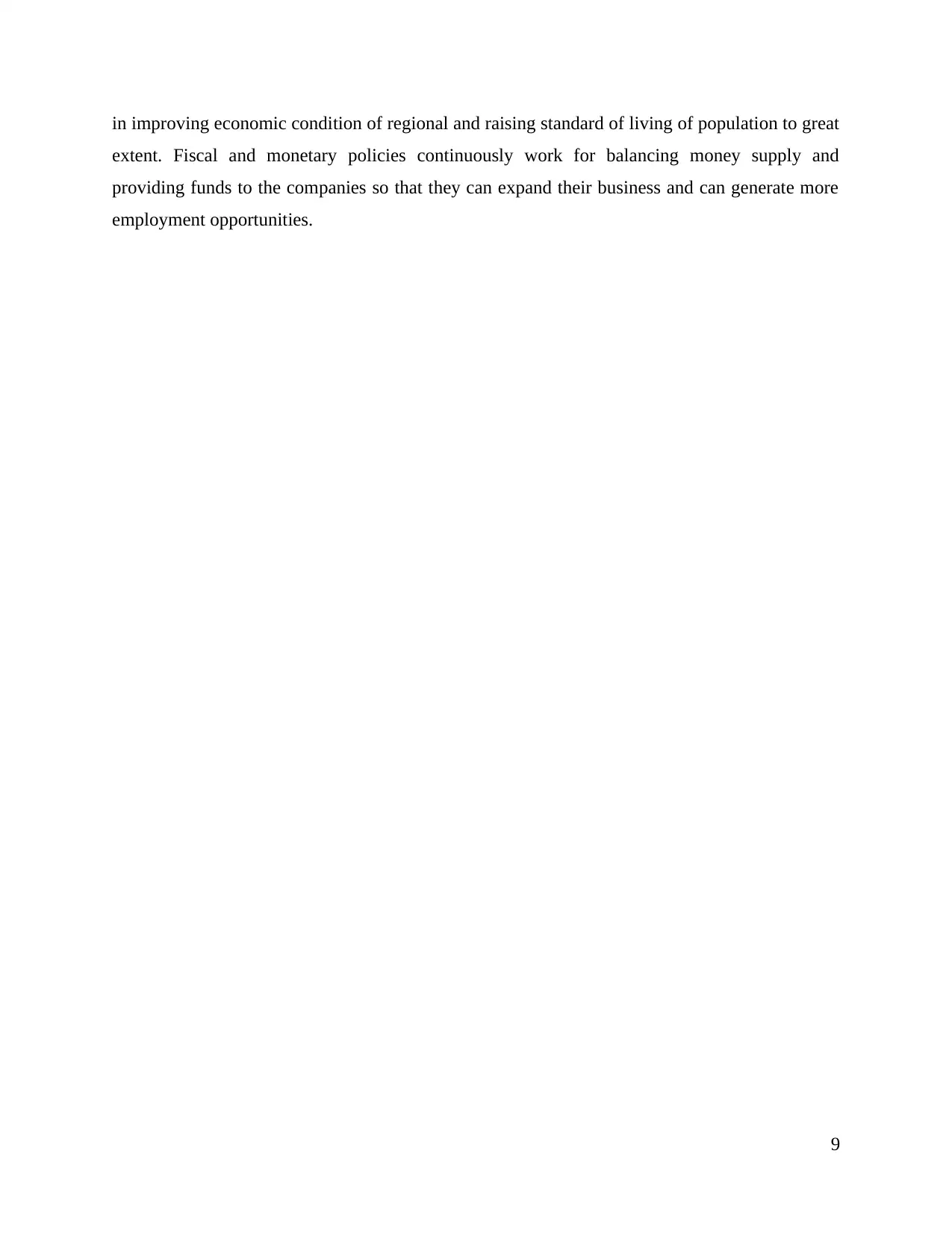
in improving economic condition of regional and raising standard of living of population to great
extent. Fiscal and monetary policies continuously work for balancing money supply and
providing funds to the companies so that they can expand their business and can generate more
employment opportunities.
9
extent. Fiscal and monetary policies continuously work for balancing money supply and
providing funds to the companies so that they can expand their business and can generate more
employment opportunities.
9
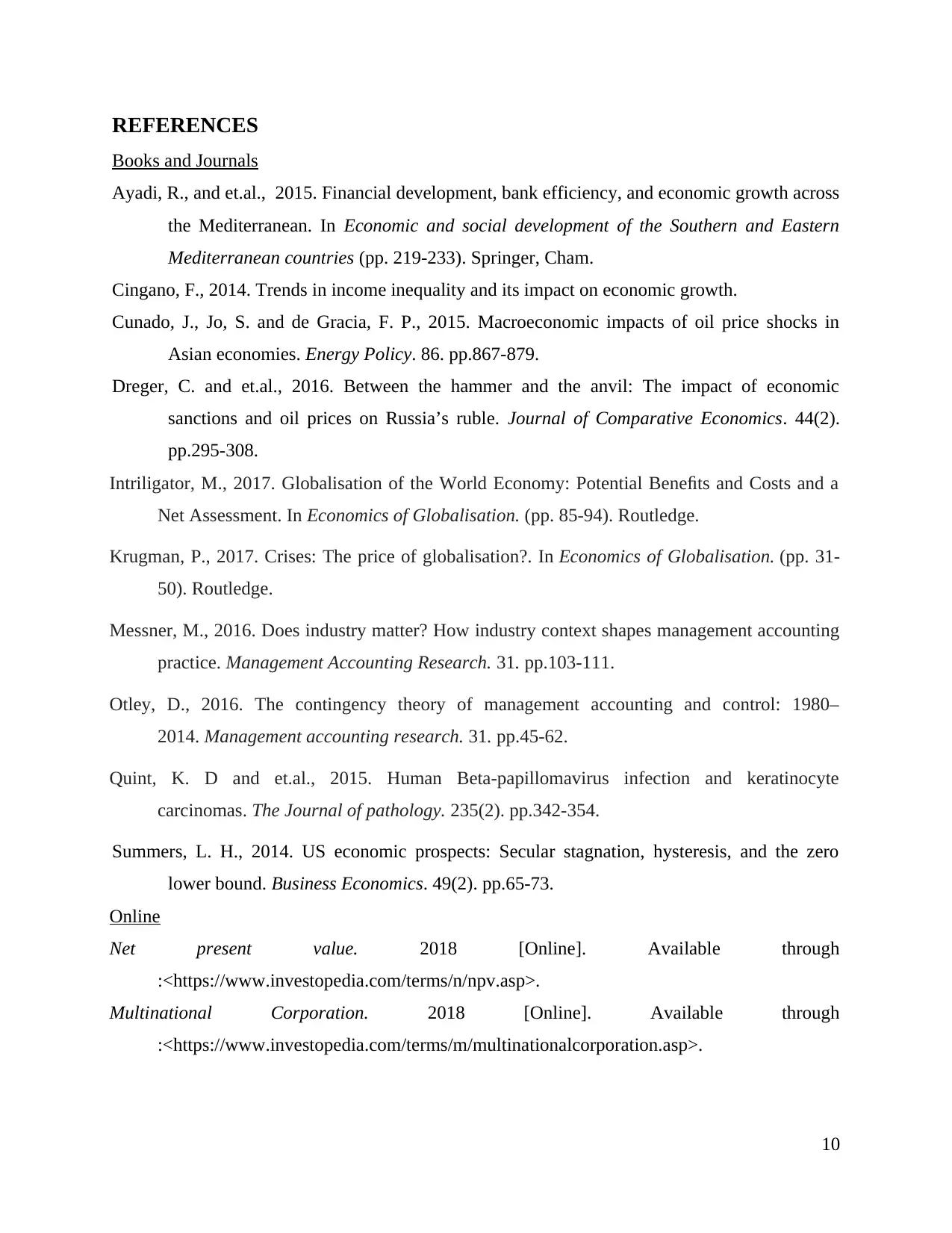
REFERENCES
Books and Journals
Ayadi, R., and et.al., 2015. Financial development, bank efficiency, and economic growth across
the Mediterranean. In Economic and social development of the Southern and Eastern
Mediterranean countries (pp. 219-233). Springer, Cham.
Cingano, F., 2014. Trends in income inequality and its impact on economic growth.
Cunado, J., Jo, S. and de Gracia, F. P., 2015. Macroeconomic impacts of oil price shocks in
Asian economies. Energy Policy. 86. pp.867-879.
Dreger, C. and et.al., 2016. Between the hammer and the anvil: The impact of economic
sanctions and oil prices on Russia’s ruble. Journal of Comparative Economics. 44(2).
pp.295-308.
Intriligator, M., 2017. Globalisation of the World Economy: Potential Benefits and Costs and a
Net Assessment. In Economics of Globalisation. (pp. 85-94). Routledge.
Krugman, P., 2017. Crises: The price of globalisation?. In Economics of Globalisation. (pp. 31-
50). Routledge.
Messner, M., 2016. Does industry matter? How industry context shapes management accounting
practice. Management Accounting Research. 31. pp.103-111.
Otley, D., 2016. The contingency theory of management accounting and control: 1980–
2014. Management accounting research. 31. pp.45-62.
Quint, K. D and et.al., 2015. Human Beta‐papillomavirus infection and keratinocyte
carcinomas. The Journal of pathology. 235(2). pp.342-354.
Summers, L. H., 2014. US economic prospects: Secular stagnation, hysteresis, and the zero
lower bound. Business Economics. 49(2). pp.65-73.
Online
Net present value. 2018 [Online]. Available through
:<https://www.investopedia.com/terms/n/npv.asp>.
Multinational Corporation. 2018 [Online]. Available through
:<https://www.investopedia.com/terms/m/multinationalcorporation.asp>.
10
Books and Journals
Ayadi, R., and et.al., 2015. Financial development, bank efficiency, and economic growth across
the Mediterranean. In Economic and social development of the Southern and Eastern
Mediterranean countries (pp. 219-233). Springer, Cham.
Cingano, F., 2014. Trends in income inequality and its impact on economic growth.
Cunado, J., Jo, S. and de Gracia, F. P., 2015. Macroeconomic impacts of oil price shocks in
Asian economies. Energy Policy. 86. pp.867-879.
Dreger, C. and et.al., 2016. Between the hammer and the anvil: The impact of economic
sanctions and oil prices on Russia’s ruble. Journal of Comparative Economics. 44(2).
pp.295-308.
Intriligator, M., 2017. Globalisation of the World Economy: Potential Benefits and Costs and a
Net Assessment. In Economics of Globalisation. (pp. 85-94). Routledge.
Krugman, P., 2017. Crises: The price of globalisation?. In Economics of Globalisation. (pp. 31-
50). Routledge.
Messner, M., 2016. Does industry matter? How industry context shapes management accounting
practice. Management Accounting Research. 31. pp.103-111.
Otley, D., 2016. The contingency theory of management accounting and control: 1980–
2014. Management accounting research. 31. pp.45-62.
Quint, K. D and et.al., 2015. Human Beta‐papillomavirus infection and keratinocyte
carcinomas. The Journal of pathology. 235(2). pp.342-354.
Summers, L. H., 2014. US economic prospects: Secular stagnation, hysteresis, and the zero
lower bound. Business Economics. 49(2). pp.65-73.
Online
Net present value. 2018 [Online]. Available through
:<https://www.investopedia.com/terms/n/npv.asp>.
Multinational Corporation. 2018 [Online]. Available through
:<https://www.investopedia.com/terms/m/multinationalcorporation.asp>.
10
⊘ This is a preview!⊘
Do you want full access?
Subscribe today to unlock all pages.

Trusted by 1+ million students worldwide
1 out of 13
Related Documents
Your All-in-One AI-Powered Toolkit for Academic Success.
+13062052269
info@desklib.com
Available 24*7 on WhatsApp / Email
![[object Object]](/_next/static/media/star-bottom.7253800d.svg)
Unlock your academic potential
Copyright © 2020–2025 A2Z Services. All Rights Reserved. Developed and managed by ZUCOL.





